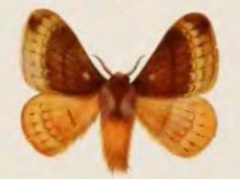Related Research Articles

Blue-ringed octopuses, comprising the genus Hapalochlaena, are four highly venomous species of octopus that are found in tide pools and coral reefs in the Pacific and Indian oceans, from Japan to Australia. They can be identified by their yellowish skin and characteristic blue and black rings that change color dramatically when the animal is threatened. They eat small crustaceans, including crabs, hermit crabs, shrimp, and other small animals.

The painted spurfowl is a bird of the pheasant family found in rocky hill and scrub forests mainly in peninsular India. Males are more brightly coloured and spotted boldly in white. Males have two to four spurs while females can have one or two of the spurs on their tarsus. The species is found mainly in rocky and scrub forest habitats unlike the red spurfowl. It is found in the undergrowth in pairs or small groups, escaping by running and rarely taking to the wing when flushed.
Alsophila lunulata is an obsolete synonym of two species of tree ferns:

The Bassian thrush, also known as the olive-tailed thrush, is a medium-sized mostly insectivorous thrush found from northern Queensland to southeastern Australia; it also occurs in Tasmania, on some larger islands of Bass Strait, and on Kangaroo Island. The thrushes range from 27 to 29 cm in length and average 100 g (3.5 oz).

The russet-tailed thrush is a species of bird in the family Turdidae, closely related to the more widespread Bassian thrush. It is found in eastern Australia and Papua New Guinea.

The western wattlebird is a passerine bird in the honeyeater family, Meliphagidae. It is restricted to south-western Australia.

Ophrys lunulata, the moon orchid, is a species of orchid native to the islands of Malta and Sicily in the central Mediterranean.

Antinephele lunulata is a moth of the family Sphingidae. It was described by Rothschild and Jordan in 1903, and is known from forests and wooded habitats from Sierra Leone to Cameroon, the Democratic Republic of the Congo, Zambia, Zimbabwe and Tanzania, as well as Madagascar.

Calliteara lunulata is a moth of the family Erebidae. It is found in the Russian Far East, Japan, China and Taiwan.

Pterolophia is a genus of longhorn beetles of the subfamily Lamiinae, containing the following species:
Tridrepana lunulata is a moth in the family Drepanidae. It was described by Arthur Gardiner Butler in 1887. It is found in Indonesia, Papua New Guinea and Australia, where it has been recorded from northern Queensland.

Cotana albaserrati is a moth in the family Eupterotidae. It was described by George Thomas Bethune-Baker in 1910. The Global Lepidoptera Names Index considers it to be a synonym of Cotana lunulata. It is found in New Guinea.

Pterolophia melanura is a species of beetle in the family Cerambycidae. It was described by Francis Polkinghorne Pascoe in 1857. It has a wide distribution in Asia.
Pterolophia instabilis is a species of beetle in the family Cerambycidae. It was described by Per Olof Christopher Aurivillius in 1922. It is known from Seychelles.
Pterolophia guineensis is a species of beetle in the family Cerambycidae. It was described by James Thomson in 1864, originally under the genus Alyattes.
Paratheocris lunulata is a species of beetle in the family Cerambycidae. It was described by Hintz in 1919, originally under the genus Latisternum. It is known from the Democratic Republic of the Congo.

The Luna lionfish, also known as the dragon's beard fish, is a scorpaenid fish of the genus Pterois native to tropical ocean waters in the western Pacific Ocean.
Myolepta lunulata is a species of syrphid fly in the family Syrphidae.
Cyclocephala lunulata is a species of rhinoceros beetle in the family Scarabaeidae.
References
- ↑ BioLib.cz - Pterolophia lunulata. Retrieved on 8 September 2014.